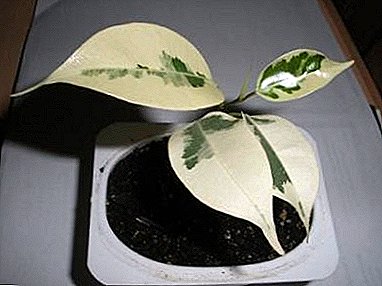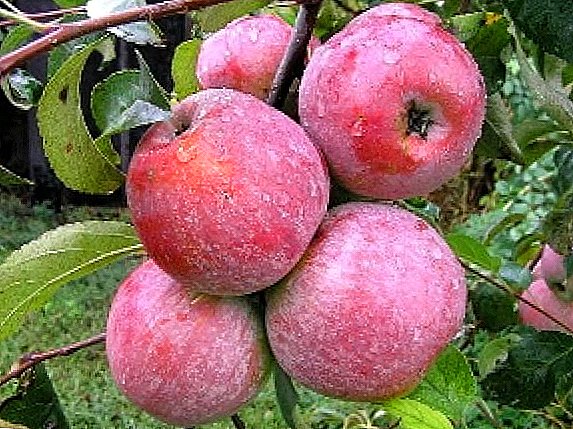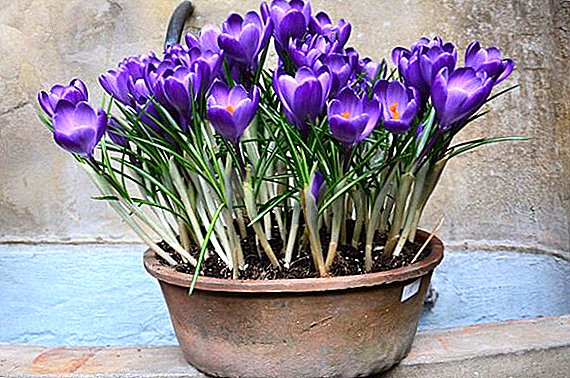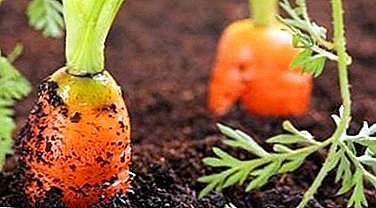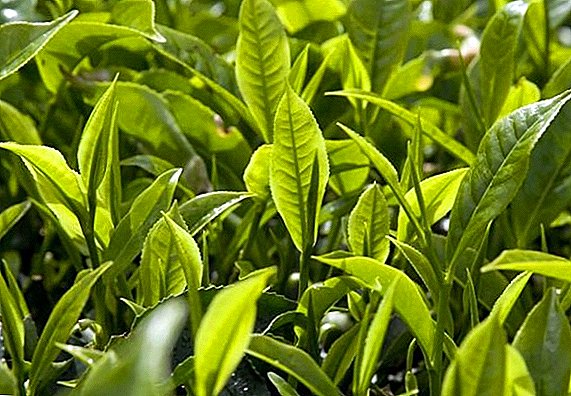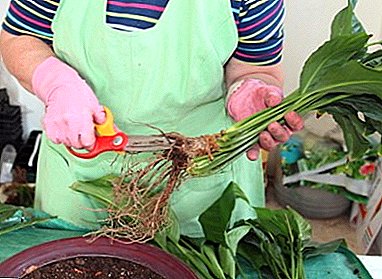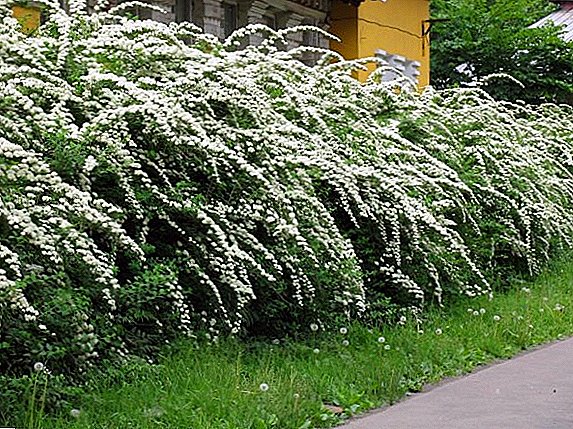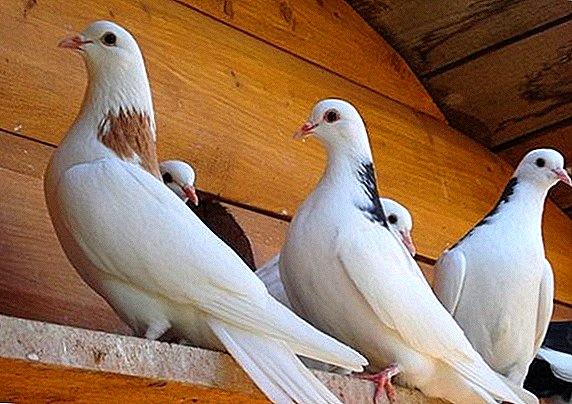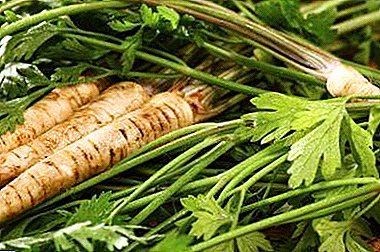
Parsley root is a fairly unpretentious plant, beloved by many gardeners and gardeners. You can grow it not only in the garden, but also in the apartment, and in the greenhouse.
It is root parsley that is two years old. For the first year she gives a root vegetable, for the second - seeds. It is this property that allows even a bunch of parsley to be harvested at the site even in early spring.
The root contains many nutrients that are used for the prevention of disease and wound healing.
Distinctive features
Unlike leafy parsley, root parsley is demanding on the soil. It is contraindicated for fresh manure, too dense or poorly cultivated soil.
This species can be planted only by sowing, because it tolerates transplant very poorly and can form a branched root crop.
Choosing a grade
 Parsley root is more cold-resistant than, for example, carrots. The plant can survive the winter in the garden and in early spring to give greens. There are three types of root parsley:
Parsley root is more cold-resistant than, for example, carrots. The plant can survive the winter in the garden and in early spring to give greens. There are three types of root parsley:
- early maturing
- mid-season;
- late ripening
One of the most favorite varieties among summer residents is "Sugar". The root crop appears only in the second year, but in the first you can gather greens. This plant belongs to the early ripening. With proper care, the crop can be up to 3 kg. The leaves are large reach 50 cm in length, and the root crop 30 cm with a diameter of 6 cm and a mass of up to 60 grams.
From mid-season varieties gardeners prefer to choose parsley "fruitful." The weight of one root parsley about 90 grams. Productivity is high up to 6 kg. Parsley leaves have bright green color and spicy aroma.. When cutting the rosette leaves grow quickly. The absolute advantage of the variety is cold resistance and the earlier appearance of tops.
Late-ripening variety and the most beloved "Bordovik". Ripened root crops are similar in appearance to carrots, reaching up to 200 grams by weight. This grade get for long storage in fresh.
Landing time
Select a place to fall. It is important to prepare the soil: dig the ground (20-25 cm) and add humus to it (5 kg per 1 sq. M). You can plant parsley at the end of April, the plant germinates at a temperature of 3-4 C.
Parsley is capricious for sowing dates, so it is important to plant until mid-May.
How to choose the right place? The place must be protected from drafts and at the same time sufficiently sunny, otherwise the plant will grow small. Parsley likes fertile soil, in no case be planted on clay and heavy soil.
Plant it with a second crop; if you plant it first, parsley will tend to branch. When choosing a place, note that the plant does not like carrots, coriander or dill to grow on this soil.
Step by step seed planting instructions
 Before planting parsley, it is necessary to properly prepare it.
Before planting parsley, it is necessary to properly prepare it.
- Two weeks before planting date, soak the seeds in warm water.
- Water change 2 times a day.
- After two days, the seeds swell, wash them and put them on the burlap or gauze for germination.
- After about 5-6 days, as the seeds germinate, put them on ice in the fridge for 12 days.
- Dry the seeds.
- Plant in moist soil, on 1 square. m of land - 0.5 kg of seeds.
In open ground
Before planting it is necessary to put potash or phosphate fertilizers into the soil. Between the beds there should be a distance of at least 20 cm, the grooves in depth should be 2 cm.
- Pour the seeds into the furrows and sprinkle with earth.
- Be sure to pour.
- Some gardeners cover the beds with a film so that the water evaporates more slowly. The film can be left until the first shoots.
- After about 2 weeks, the first shoots will appear.
The plant gives greens to frost., so you can leave it until late autumn.
On the windowsill
For planting parsley at home, it is important to pick a pot. In an average flower pot three fruits will be located. You can purchase deep containers or boxes, such a vessel will also work. The distance between plants should be 3 cm, if you have several rows, then between them - 8 cm.
Ventilate the room regularly, avoid drafts and maintain the humidity of the earth. Parsley can grow at home all year round.but not on the balcony or loggia.
In the greenhouse
 Planting plants in the greenhouse is almost the same as planting in open ground, but you can plant in the greenhouse at the end of January.
Planting plants in the greenhouse is almost the same as planting in open ground, but you can plant in the greenhouse at the end of January.
The soil in the greenhouse should be slightly loamy or tree podzol. Fluorescent lamps can be used for good lighting..
Do not forget to air the greenhouse. Movable tunnels and drip irrigation are excellent for growing parsley.
Care for a young plant at first
- During the period of plant growth, it is necessary to feed it. Phosphorus-potassium fertilizers are ideal for this. During the growing season, 2-3 additional feeding is necessary. The first dressing, when parsley released 3-4 leaflets.
- Immediately after the sprouting of greens, it is necessary to thin the parsley and break through the soil. The distance between the plants should be about 3 cm.The first loosening for a young plant is done not too deep - 5-6 cm. Subsequent - 10-15 cm. Loosening is necessary after each watering and rain.
- Watering is done in the morning or in the evening. In wet weather, reduce the number of irrigations, with dry increase. The soil should not be too wet or dry.
- Before the emergence of shoots, it is important to air the room (including the greenhouse), avoid drafts, regularly moisten the soil and remove weeds.
Possible difficulties
Root parsley does not tolerate transplanttherefore, it should be planted in a permanent place. It is better not to use a seedling landing method. Also parsley gives long shoots. But if you soak the seeds (as we wrote above), then there will be no difficulties.
At the time of planting in the winter, it is necessary to use twice as much seed. There is a risk that I will not grow all the seeds.
Parsley root is great for growing both at home and on the garden. Her greens can be used in fresh and dried form, and the root vegetable is perfect for salads, as well as for the preparation of natural seasonings.


